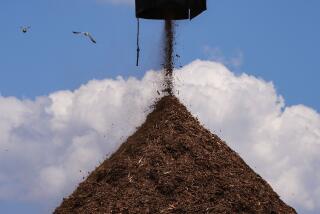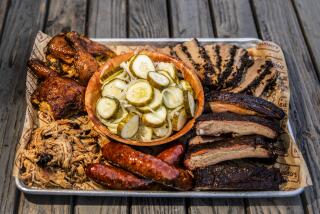Home Improvement : Wood-Pellet Barbecues Are Efficient, Clean
- Share via
QUESTION: I heard that new natural wood-pellet barbecue grills make foods taste better and burn cleanly. Do they cost more to operate than gas or electric models and what else is new in efficient barbecues?
ANSWER: New wood-pellet barbecues are convenient and efficient to use. By cooking over 100% real wood (renewable energy), you get that authentic “camp fire” flavor. The pellets are available in mesquite, cherry, hickory, alder and maple for unique flavors.
Pellet barbecues incorporate a small built-in auger and blower, but they look like typical gas barbecues. They use very little electricity and a small 10-pound bag of pellets should last for five cookouts.
A small hopper holds several pounds of wood pellets. The auger slowly feeds the pellets to the grill burner area. The auger speed is adjustable to control the barbecue temperature and smoke flavor.
The blower circulates air through the pellets for a hot pollution-free fire. This also circulates air around the food for true smoked flavor. You only have to preheat it for about five minutes before grilling food.
There are new super-efficient futuristic-looking domed electric barbecues. These full-sized barbecues have a double wall insulated cover and use corrosion-resistant aluminized steel to retain heat. They use less electricity than a typical hair dryer.
Heating elements are built into the non-stick grill surface so there is less than a 25-degree temperature variation across it. This allows you to use the entire grill surface and reduce total cooking time. The circular domed top also creates natural air circulation inside to enhance flavor.
Other features to consider are an adjustable top vent that provides precise control over the temperature and flavor. Smokers, with a water pan/steam heat feature, keep meat tender with added smoked flavor. An aluminized steel shell is also efficient when used on gas barbecues.
A built-in drip vaporizer over the burners reduces flare-ups and improves the taste of the foods. A new “behind heat” (instead of under) rotisserie burner design roasts foods with less burnt taste and half as much gas.
There are new charcoal briquettes filled with real wood chunks. This provides the intense heat of charcoal with the flavor of real wood barbecuing. Keep in mind that burning charcoal produces more air pollution (100 times more CO gas) than using gas or electric barbecues.
Write for Utility Bills Update No. 642 showing 17 manufacturers of new real wood-pellet, electric and gas barbecues listing maximum heat outputs, cooking area size, easy-clean grill finishes and new features, and wood/charcoal briquettes suppliers. Please include $2 and a self-addressed envelope.
Send your requests to James Dulley, c/o Los Angeles Times, 6906 Royalgreen Drive, Cincinnati, Ohio 45244. Allow three to four weeks for delivery.
How to Make an Old House More Airtight
Q: I am trying to make my old house more airtight by installing draft sealing foam gaskets in my wall electric outlets. The package says that I should put them in all the wall outlets. Is this correct?
A: You should only put them behind the outlet faceplates on outdoor walls. Most builders do not seal around the conduit boxes during construction and this is one of the major areas for air leaks.
Little outdoor air, if any, should get into the interior walls of your home, so the draft sealers are not needed behind those outlet faceplates. Even though installing gaskets is a simple job, anytime you remove a electrical outlet faceplate, switch off the circuit breaker first.
Why Do Windows Have a Bluish Tint?
Q: I just bought a 5-year-old house and the windows have a very slight bluish tint on sunny days. The seller told me that they were high-efficiency windows. Should they be bluish?
A: The sellers probably were telling you the truth. A bluish tint, when viewed from outdoors, is not uncommon with low-e (low-emissivity) glass. The low-e windows in my own home look this way on a sunny day.
A low-e coating, on the inside surface of double-pane windows, lets visible light through, but blocks heat loss. This type of glass is quickly becoming the standard replacement window glass.
Letters and questions to Dulley, a Cincinnati-based engineering consultant, may be sent to James Dulley, Los Angeles Times, 6906 Royalgreen Drive, Cincinnati, Ohio 45244.
More to Read
Eat your way across L.A.
Get our weekly Tasting Notes newsletter for reviews, news and more.
You may occasionally receive promotional content from the Los Angeles Times.










